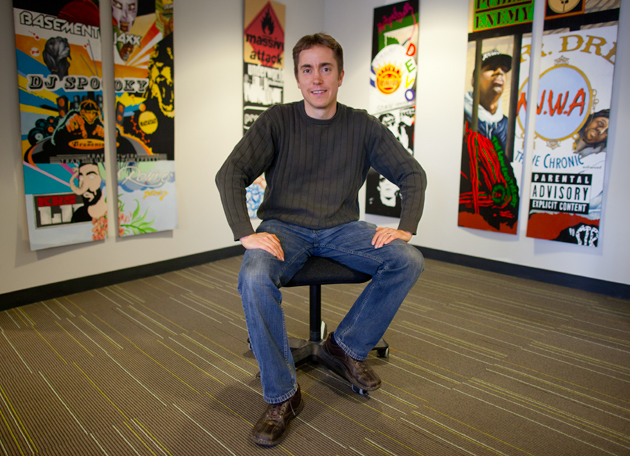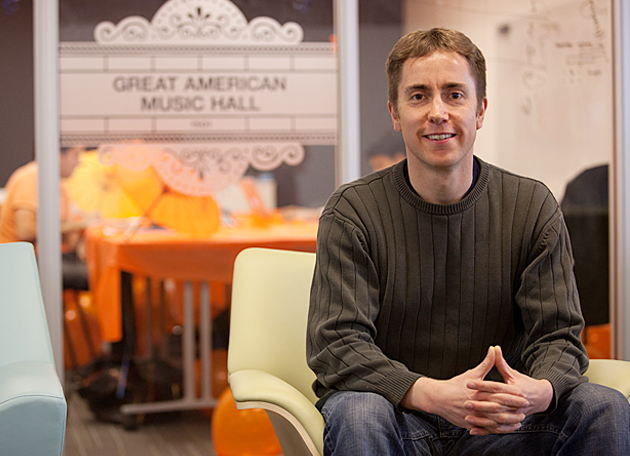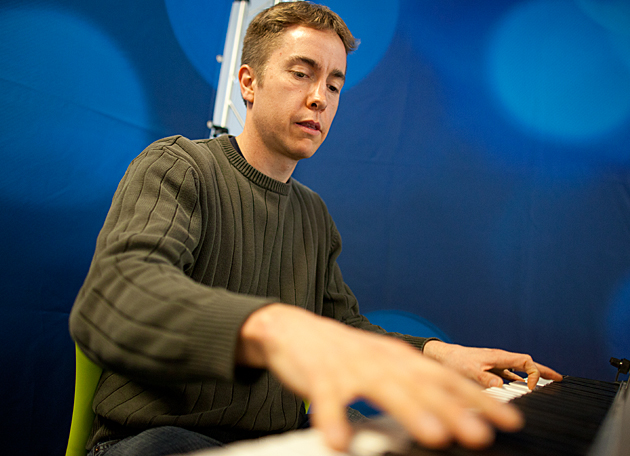
When music aficionados and musicians looking for a day job come knocking at Pandora’s headquarters, in Oakland, Calif., hoping to be hired as a music analyst, Steve Hogan must decide who makes the cut.
Hogan, AB ’96, performs as music operations manager for the online radio station. Analyzing music for the company since 2000, he was part of the team that kept the company alive when founder Tim Westergren struggled to find a funder for the fledgling startup.
Pandora® allows you to create your own custom radio stations online — an all-bluegrass station, if you like, or an invigorating, get-your-blood-pumping “workout” station, if that’s your thing. Pandora helps you find new music by adding songs to your mix that are similar in fundamental ways to the music you’ve already told it you like.
To do this, Pandora draws from an enormous database of songs codified by hundreds of musical traits into a proprietary Music Genome Project®. Songs are analyzed according to hundreds of attributes (up to 450 per track) or “genes” such as harmony, level of distortion on the electric guitar, grittiness of the vocals, etc. Some of these attributes are easy to define, like tempo, while others are harder to pin down, like the emotional content of a particular recording.
“The bottom line is we are looking for some of the biggest music nerds out there.”
—Steve Hogan, AB ’96
Because these qualities can only be assessed by real people listening to each and every one of the 900,000 or more tracks that comprise Pandora’s playlist — and the company adds 10,000 new songs each month — all of this translates into a lot of listening for the analysts on Pandora’s payroll.
“The bottom line is we are looking for some of the biggest music nerds out there,” Hogan says.
Getting in on the ground floor
Hogan was hired as analyst No. 18, in 2000. “I learned a lot in that first year,” he recalls. “I feel as if my ear for music grew so much.”
Today, Pandora is a success story, with more than 125 million registered listeners accounting for more than 60 percent of all Internet radio listening in the United States. In 2011, it became the No. 2 all-time downloaded free iPhone app and the No. 7 all-time downloaded free iPad app. Pandora is also available on many new cars and trucks — the company has formed partnerships with 16 automotive brands (Acura, BMW, Buick, Cadillac, Chevrolet, Ford, GMC, Honda, Hyundai, Kia, Lexus, Lincoln, Mercedes-Benz, MINI, Scion and Toyota) and seven aftermarket manufacturers (Alpine Electronics, Audiovox, Clarion, JVC, Kenwood, Pioneer and Sony).
But Pandora struggled during the startup stage, swinging wildly at times between feast and famine. Though the organization had grown in 2000 to include 32 music analysts, Hogan recalls: “It literally dwindled down to just me by somewhere mid-2001.”
“In a typical week, I would come in, research the Billboard charts and the CMJ charts, and make a list of albums we needed to get,” he recalls. “Then I would drive over to Berkeley to the big record stores, and I would go on a shopping spree.”
“Then, after pitching the idea a million times, Tim (Westergren) finally found a sympathetic investor and managed to turn things around. The deal closed, and he called me back. It was like: ‘We’re back on!’”
—Steve Hogan
Once back at the office, Hogan would “rip,” or copy, the audio from the CDs he’d bought. Back then, he would analyze just one song per album because, being short on staff, the company couldn’t afford to have him spend much more time than that on the task. “For a while there, it was really just a ‘keep-the-lights-on’ operation,” he says.
The lowest point came just before Christmas in 2001, when Hogan and nearly everyone else at the company was laid off.
“So I went and did a little temp work. It was quite depressing, but that lasted for only two weeks,” Hogan recalls. “Then, after pitching the idea a million times, Tim finally found a sympathetic investor and managed to turn things around. The deal closed, and he called me back. It was like: ‘We’re back on!’”

New Genres To Explore
Though the bulk of its recordings are music, Pandora has branched out to comedy, hiring comedians as analysts who apply the same genome concept to the spoken word.
“With comedy, it’s just different categories,” Hogan explains. “Take delivery style: Are they sarcastic? Are they neurotic, like Woody Allen? Are they deadpan or animated in their delivery?”
Hogan says he loves to listen to comedy during his commute time. At home, jazz is his favorite musical genre. (“I have my Coltrane station and Miles Davis, of course,” he says.)
With much of his day occupied by professional listening, Hogan still manages to separate work from play. “People ask me: ‘Can you still listen and just enjoy music, or are you always thinking of it like a scientist?’” Hogan says.
“I definitely can turn it off,” he continues. “When I go home, if I put music on, I can still very much sit down and just enjoy it and have an emotional reaction to it. I’m not always sitting there trying to chart out the chords in my head.”

A Musician At Heart
Trained as a pianist, Hogan moved to the San Francisco Bay Area not to work in technology, but to play with a friend in a band, now defunct. He still teams up sometimes to play with Pandora employees in after-work gigs. Occasionally, he manages to tour. (“We try to get all the way across the country and back in two weeks, sort of breakneck,” he says.)
“My one regular gig nowadays is to play the organ for the San Francisco Giants,” Hogan says. He began playing at AT&T Park in 2010 — the same year the team won the World Series.
Hogan carts in his own portable Hammond organ to each of the daytime home games and sets up shop in center field. He keeps a running list taped to his keyboard of short riffs that he can pull out at key moments.
Living on campus as an undergraduate, “we’d stay up until early in the morning just listening to music and breaking it down. It’s funny — I mean, we were doing this in the dorms!”
—Steve Hogan
If, for example, the visiting team’s pitcher is not doing well and the catcher and the manager come out to the mound, he might play a bit of the Three’s Company sitcom theme song. “Sometimes it’s snarky, sometimes funny, sometimes genuinely trying to pump people up,” he says.
Hogan’s wife and kids join him occasionally for ballgames. Hogan married his college sweetheart, Joanna (Millstein, AB ’96), and the couple has two children: Brady, 6, and Liam, 2.
Hogan’s shift toward a musical career might come as little surprise to friends from his college days — he played jazz piano in the Big Band while at Washington University, and he spent many nights listening to local jazz talent at the Moose Lounge in St. Louis’ Penrose neighborhood.
Living on campus as an undergraduate, Hogan often stayed up late listening to music with his roommate. “We’d stay up until early in the morning just listening to music and breaking it down. That really prepared me for what I am doing here at Pandora,” he says. “It’s funny — I mean, we were doing this in the dorms!”
Gretchen Lee, AB ’86, is a freelance writer based in San Francisco.
Comments and respectful dialogue are encouraged, but content will be moderated. Please, no personal attacks, obscenity or profanity, selling of commercial products, or endorsements of political candidates or positions. We reserve the right to remove any inappropriate comments. We also cannot address individual medical concerns or provide medical advice in this forum.